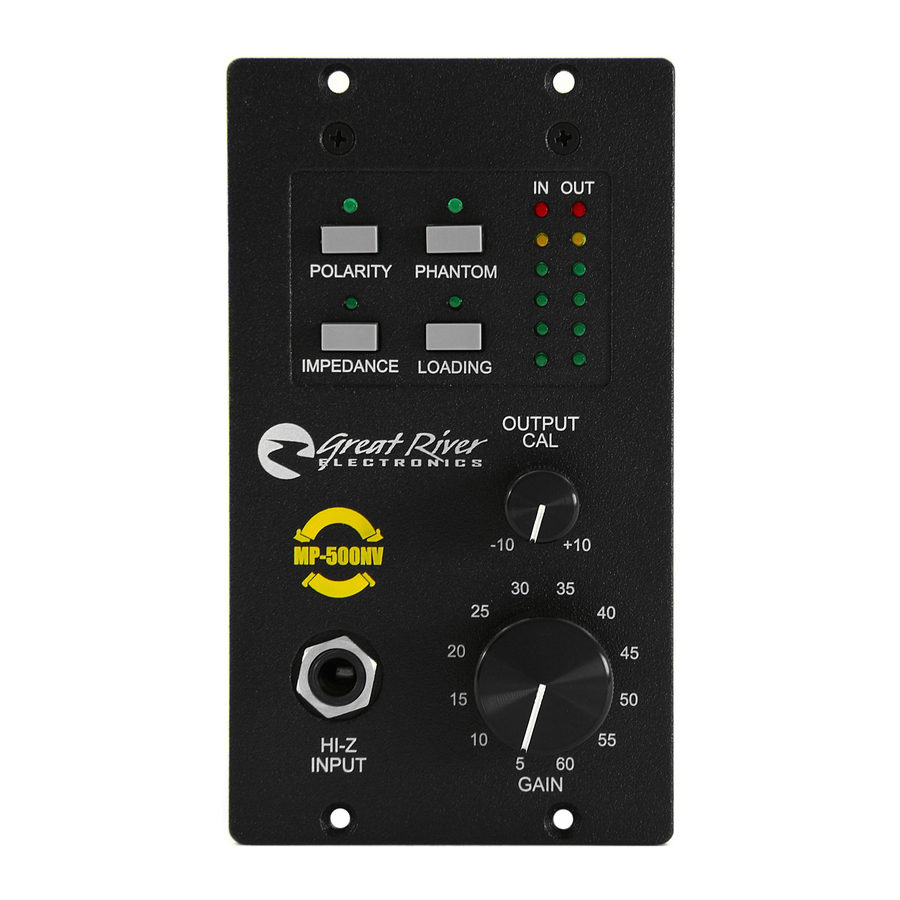Great river MP-2NV Manuale d'uso - Pagina 4
Sfoglia online o scarica il pdf Manuale d'uso per Amplificatore Great river MP-2NV. Great river MP-2NV 8. Nv series microphone preamplifier & di

Definitive
A
u
d
i
o
D
e
s
i
g
n
A u
u d
d i
i o
o D
D e
e s
s i
i g
g n
n
A
Be sure to check the polarity of all of your mic inputs when doing a multiple input mix, such as a
drum kit, or a guitar amp with several mics. For instance, if you are miking the top and bottom of
a snare simultaneously, the bottom mic should have it's polarity reversed in relation to the rest of
the set. If you are miking an open backed guitar amp from in front and in back, the rear mic
should have it's polarity reversed. Listen both ways, at least, to determine what works best for the
track.
Impedance
The input load for the microphone and the Hi-Z buffer can be switched from 1200 ohms to 300
ohms. When the button is in the out position, the input load is 1200 ohms. When the button is
pushed in, the input load is 300 ohms.
Great River Tips:
Most microphones will work best with the 1200 setting. Best isn't always what you want though.
With most microphones, the result of using the 300 ohm setting will be a roll off of the lowest
frequencies and a tilt upwards of the highs. This effect is highly dependant on the particular
microphone, and the only way to know for sure is to try it.
Keep in mind that the impedance change is accomplished by changing the step-up ratio of the
input transformer, so a gain change happens as well. Don't let the volume difference mask the
tonal difference when determining your preference.
In general, the best mics to try changing the impedance selection effect on are dynamics and
ribbons. Condenser microphones have built in amplifiers, and the usual effect of running them
into a lower impedance than they like to see is just a large increase in distortion and lower
headroom, with minimal tonal changes.
The DI is similar to a condenser microphone, in that it doesn't change tonally much, but has
much different distortion characteristics with the different loads presented by the two impedance
selections. This can be used to great advantage when recording electronic instruments that need
a little more body.
Loading
This button controls the output termination relay. When in the out position, the output
transformer is unloaded. When pushed in, a 600 ohm resistor is connected across the
secondary.
Great River Tips:
The output transformer has an inherent resonant peak that affects the frequency response at high
frequencies. This peak is at approximately 50kHz, and is about 6db up from flat and is cable and
load dependant. The amplifier is designed to be correctly loaded by 600 ohms for best flatness
in both frequency and phase response, but some interesting effects happen when unterminated.
A gentle high frequency lift, like an "air band" EQ and a bit grittier midrange are the effects you
should hear when the loading button is out.
Definitive
A
u
d
i
o
D
e
s
i
g
n
A u
u d
d i
i o
o D
D e
e s
s i
i g
g n
n
A
D
e
f
i
n
i
t
i
v
e
Audio
D
e
s
i
g
n
D e
e f
f i
i n
n i
i t
t i
i v
v e
e
D e
e s
s i
i g
g n
n
D
D
www.greatriverelectronics.com
D
e
f
i
n
i
t
i
v
e
Audio
D
e
s
i
g
n
D e
e f
f i
i n
n i
i t
t i
i v
v e
e
D e
e s
s i
i g
g n
n
D
D
www.greatriverelectronics.com
D
e
f
i
n
i
t
i
v
e
A
u
d
i
o
Design
D e
e f
f i
i n
n i
i t
t i
i v
v e
e A
A u
u d
d i
i o
o
D
D
e
f
i
n
i
t
i
v
e
A
u
d
i
o
Design
D e
e f
f i
i n
n i
i t
t i
i v
v e
e A
A u
u d
d i
i o
o
D
Page 3of 6
